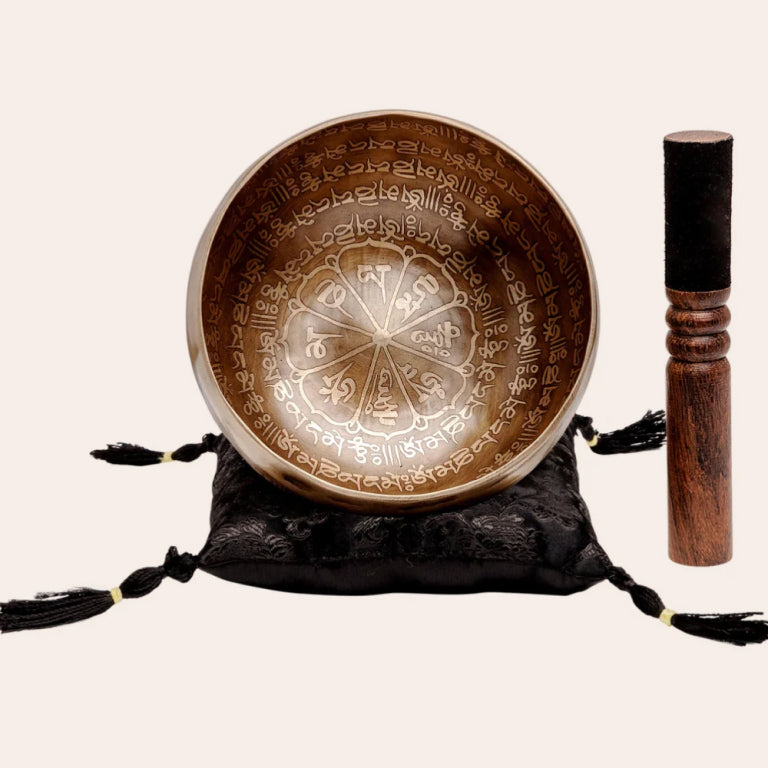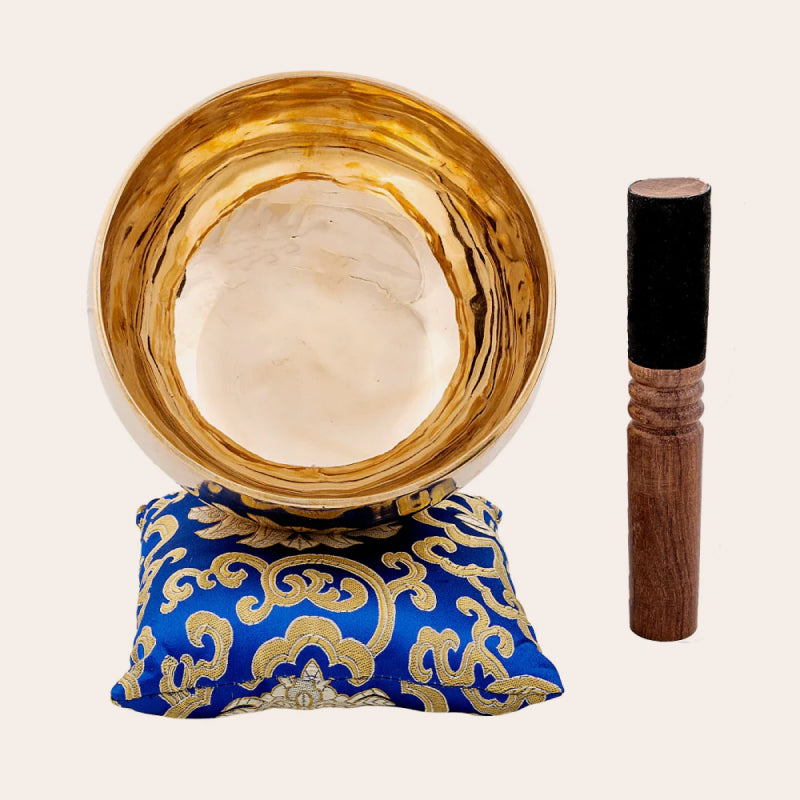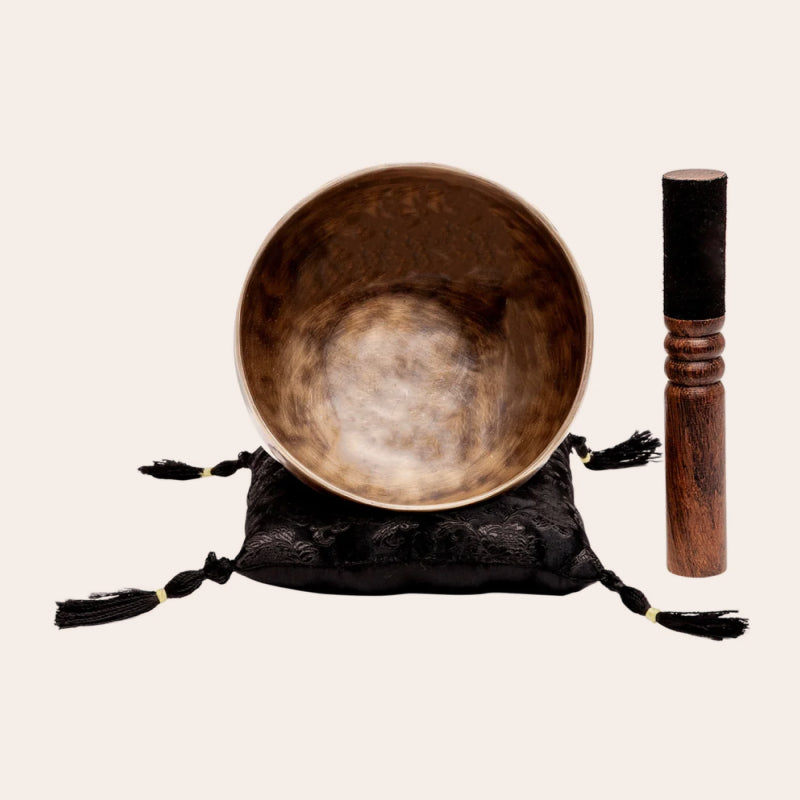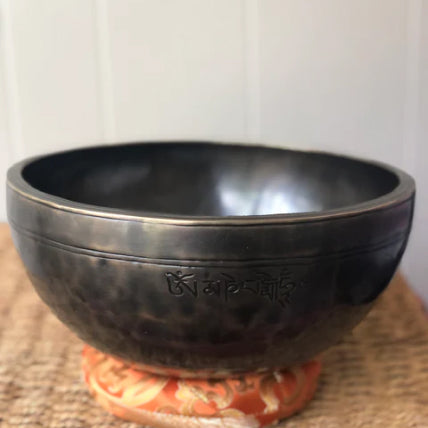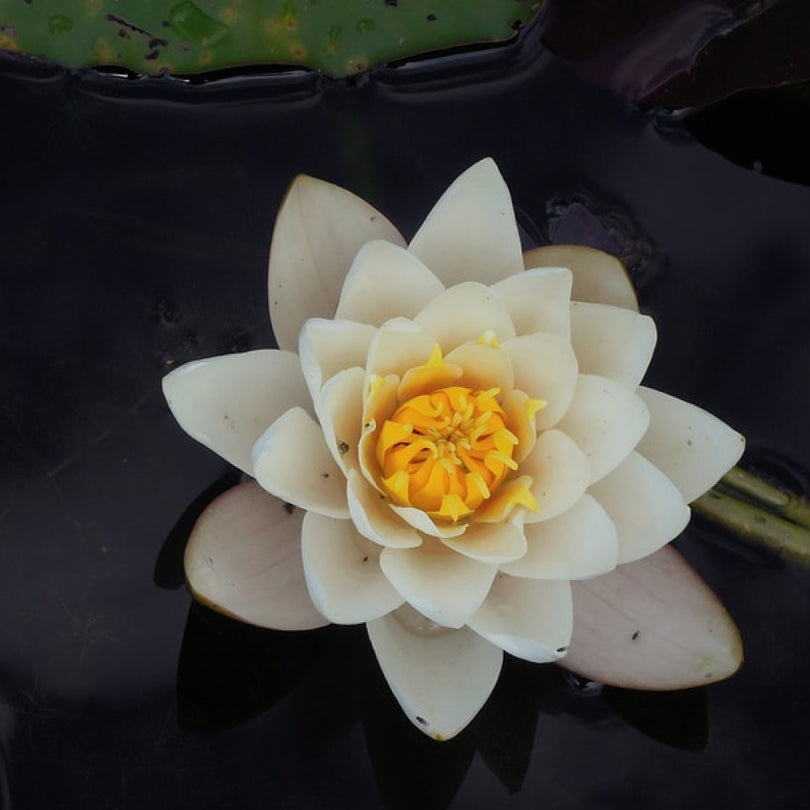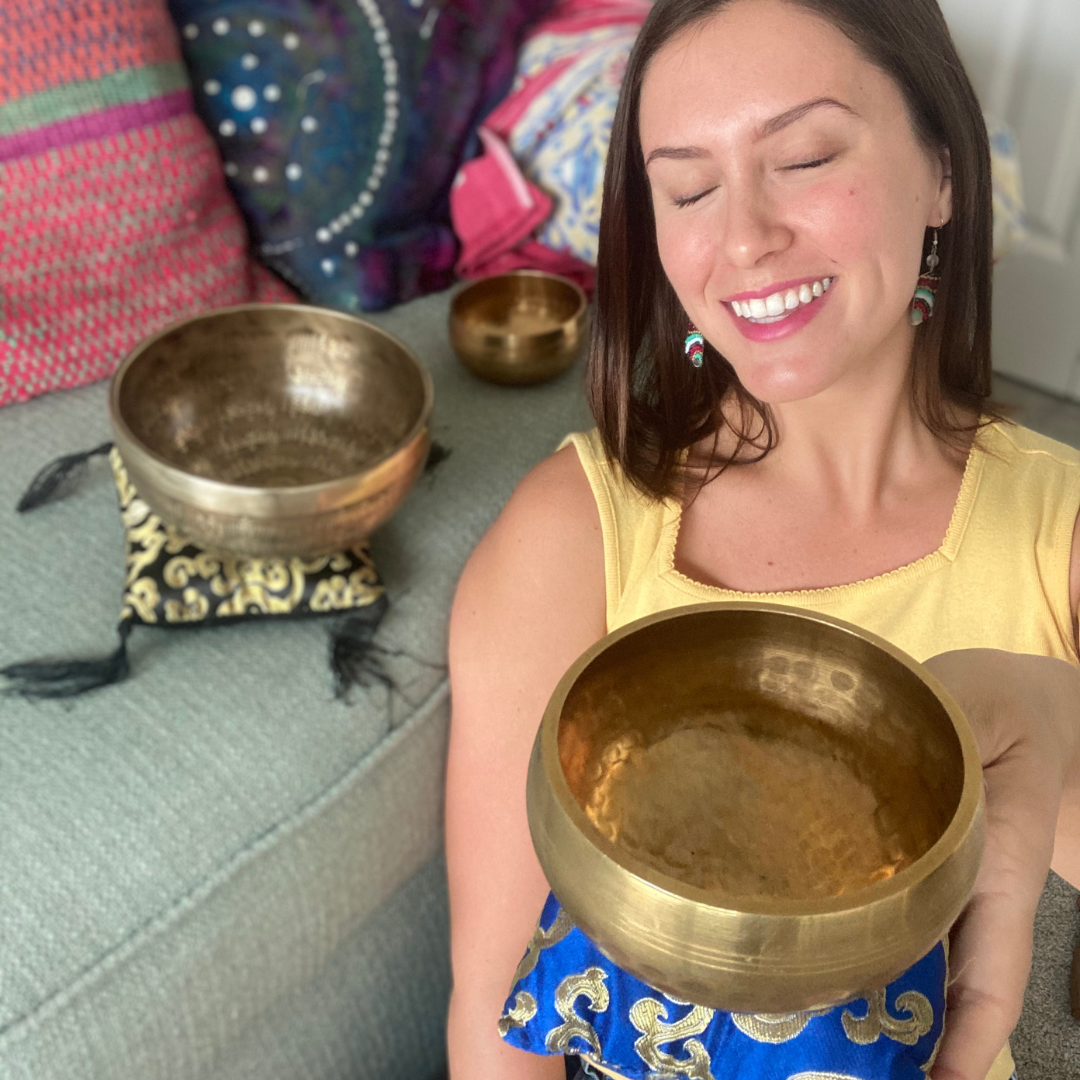Using Mantras With Singing Bowls - The Science And History
"Mantra" translates to the language used to communicate with the God/universe/higher power."
While they come from Sanskrit language - affirmations, spells, incantations, and phrases are all referring to the same idea.
Through a combination of sacred words, the vibration of sound, and thoughts, you can cleanse, charge, and amplify the healing vibrations of singing bowls with mantras.
I’ll talk about where mantras come from, their benefits based on scientific studies, ways to use with singing bowls, and 15 mantras from different religions.
Basics: History Of Mantras, Chants, Spells, And Affirmations
Mantras are chants in the Sanskrit language taken from Hindu and Buddhist scriptures. They don’t often make sense when out of context, because they are meant for communicating with energies, God, and the Universe. Not directly withj another person.
So, mantras are emotive words based on spiritual symbols, uses, and meanings. Alternatively, you can call them prayers.
The use of Hebrew or Aramaic words in prayers of Judaism and Christianity are prime examples of western use of mantras. In the same way, Sanskrit is the sacred language used in Hinduism and Buddhism. Gregorian chants are another extension of Sanskrit mantras too!
But mantras aren’t limited to Sanskrit.
A mantra or mantram denotes a “sacred utterance, sound, syllable, or group of words.” It comes from the root word ‘man’ (pronounced mŭn/ mʌn), meaning to think.
Scholars define mantras as a thought and others as a formula of thoughts. In both cases, mantras help to unlock some type of special power, or energy.
The power of a mantra is in the utterance, and metaphysics hidden between the lines. You can say the sound is more important than the literal meaning. Hence, they’re like spells, affirmations, chants, and incantations.
What Are The Uses Of Mantras?
Mantras were used to solemnize rituals, oust negativity, and attract spiritual benefits in Vedic rituals. Similarly, spells were used to destroy negativity, exorcise demons, and empower or bless something in Wiccan rituals.
So, mantras are tools to eliminate negative energies.
We recently learned how sound impacts the body and how sound can bring about positive and negative changes.
Along the same line, “mantras have the inherent ability of words to influence the universe”- S. J. Tambiah, Harvard Anthropologist.
That may be why mantras are essential for meditation in Buddhism and Hinduism.
No wonder Gregorian chants are found to
Mantras help you focus by controlling your heartbeat, breathing rate, and even thoughts for wellness exercises like meditation and yoga.
When your sound, energy (vibration), and thought come together to communicate with the universe, you can easily set intentions and turn them into manifestations.
The exciting thing is that the energy of these manifestations can be further “amplified” by adding healing crystals, essential oils, and singing bowls to the mix.
Science Behind The Power Of Affirmations: What Are The Benefits Of Mantras?
Mantras are quite like affirmations.
So what does science say about their effects on the body?
The short answer is “a lot.”
So, how does chanting mantras affect your brain?.
Most of us already know thoughts contain energy.
Scientifically speaking, thinking itself is a complex mix of electrical signals secreted by neurotransmitters in our brain. With repetition, thoughts can even change your brain wiring (NCBI).
So, mantras can change neural pathways to emit hormones that make you feel positive, hopeful, and calm when chanted repeatedly. The good news is, it’s proven too!
Chanting can also relax your muscles and joints to reduce stress. It’s so effective because “chanting increases the stability of cardiac activity” (Scientific Report).
As a result, mantras can increase your self-esteem and confidence!
Another research published in 2009 shows that the blood flow in your brain changed positively with chanting meditation.
When it comes to Sanskrit and Gregorian chants, Dr. Glen Rein found that they can repair and restore the human DNA, unlike rock music.
Over 10 Mantras, Chants, And Affirmations You Can Use With Singing Bowls
A famous mantra from Sanskrit most of us are aware of is OM, OHM, or AUM. It’s called the sound of the Big Bang or the first sound of the universe.
The exciting thing is that simply chanting the word ‘OM’ for ten minutes improved the attention and mood of participants in this 2016 study.
Nonetheless, there are many more mantras like OHM in Hebrew, Hawaiian, Latin, and Arabic.
Let’s look at ten of them!
Yod He Vav He (Hebrew)
These are the four different Hebrew words to address the Lord. That’s why Christians believe it’s a powerful mantra for salvation.
The Hebrew mantra can be written as He Yod He, meaning “to exist” or “to be.” Hence, scholars also say it means the same as the Sanskrit verse Ham-Sah or Soh-Ham, which means “to exist.”
Why chant this Hebrew incantation? It’s a great way to connect with the higher power you believe in.
Om Shanti Shanti Shanti Om
One of the popular Sanskrit mantras for peace (shanti is the Sanskrit word for peace), this mantra is uttered by people of all religions and ages in schools, monasteries, and prayers.
Om Shanti is a great way to start your day and end it with peace, if you ask me.
Om Shanti is also chanted at funerals as it bids a peaceful farewell to departed souls.
Ho’oponopono (Hawaiian)
While this Hawaiian mantra literally means “to make things right,” it’s not just a mantra.
Ho’oponopono is a chant for forgiveness or salvation.
Hawaiians believe chanting this mantra cleanses sins in your mind and body. When you chant this repeatedly, you take “complete responsibility” for your sins to repent and reconcile.
Lumen De Lumine (Latin)
Lumen de Lumine means “the light from light” or “god’s light” in Latin. This isn’t a mantra specific to any religion, so anyone can chant it.
When you chant this Latin mantra repeatedly with singing bowl sounds, it opens your heart and envelops you in godly light.
Even listening to Lumen De Lumine is enough to clear your energies and emanate an indigo aura from your head.
Nam Myōhō Renge Kyō (Japanese)
This is the Japanese mantra of prayer. It’s translated as a “devotion to the mystic law of the Lotus Sutra.”
Here, Namu means “bowing” like the Sanskrit word Namah, Myōhō refers to the “exquisite law,” and Renge-kyō, the Lotus sutra.
Altogether, Nam Myōhō Renge Kyō refers to the Buddha wisdom necessary for achieving Buddhahood.
Allahu Akbar (Arabic)
Allahu, or Allah is an Arabic word for God.
Hence, Allahu Akbar together means God is the greatest.
So, it’s a powerfully simople Arabic prayer for connecting with your God.
Elohim Hayyim (Hebew)
Prevalent in Christianity and Judaism, Elohim ḥayyim translates to “the living God.”
That’s why chanting it before praying or singing bowls brings you closer to the God of Israel and hope.
Elohim Hayyim is often interchanged with the Arabic word Allah.
Abracadabra
A word to protect from bad luck and evil energies, Abracadabra isn’t hocus pocus.
Ages ago, Abracadabra was written several times on papyrus in the shape of a diminishing triangle and worn as an amulet to diminish evil energies on the wearer.
Veritas Vos Liberabit (Latin)
The literal meaning of the Latin mantra is “the truth will set you free.”
This is the Latin verse for seekers of truth and spiritual destiny. It’s a great way to meditate for lawyers, healers, and seekers with singing bowls at the start of the day.
Om Mane Padme Hum
We’ve already translated the meaning of this Tibetan mantra seen on singing bowls in a recent post.
In brief, Om Mane Padme Hum means “jewel in the lotus.” It refers to the enlightenment of Buddha and is believed to be the condensed format referring to thousands of his teachings.
Read more about Om Mane Padme Hung.
How To Use Mantras With Singing Bowls?
Mantras are the easiest ways to set an intention. You now know almost a dozen mantras, their meanings, and their uses. So, I’ll explain a few ways to use them with Tibetan bowls next.
Mantras empower the body, mind, and soul with healing vibrations of sound energies. You can chant any of the above mantras or even create your own mantras with affirmations. Then, you can chant them before, after, or during a singing bowl session.
Final Thoughts: What’s The Use Of Combining Singing Bowl With Mantras?
Mantras are a positive string of letters, words, or phrases used for communicating with the universe. That’s why they can cleanse chakras, auras, physical body, and spirit to manifest your desires!
In Sanskrit, there are specific syllables for cleansing the seven chakras, such as LAM (root chakra), VAM (sacral chakra), RAM (solar plexus chakra), YAM (heart chakra), HAM (throat chakra), OM (third eye chakra), and OHM/AUM (crown chakra).
But chakra syllables aren’t limited to Sanskrit alone. A few weeks ago, we learned about Tibetan warrior syllables associated with the five Tibetan chakras- A, Ohm, Hung, Ram, and Dza.
Now you know 10 more mantras and how to use them with singing bowls. If you don’t want to repeat a popular mantra, create your own affirmation and chant it before, after, or when playing your singing bowl to amplify its energy!
Sounds easy, right? That’s the thing about mantras. It’s as easy as speaking!

